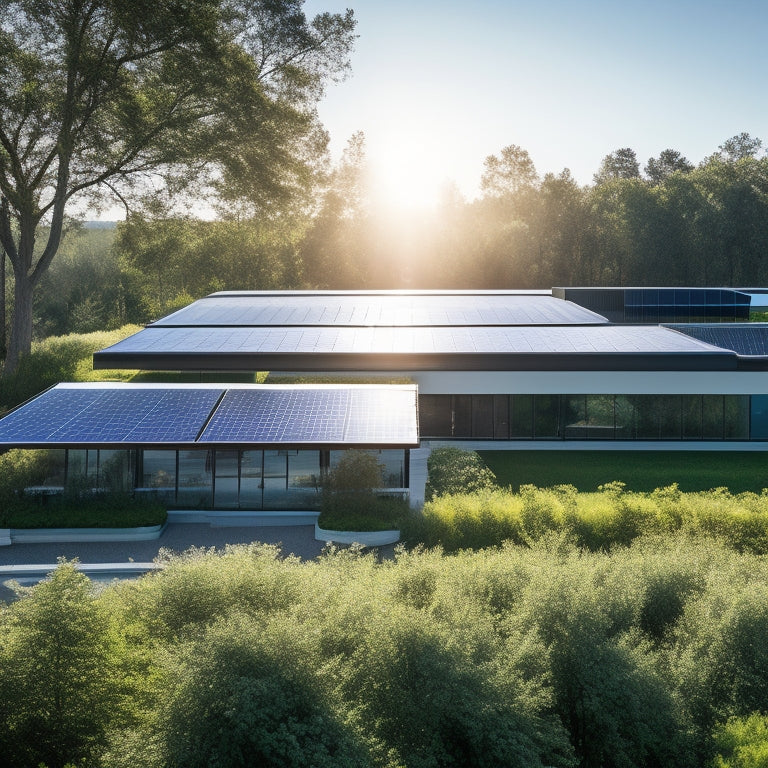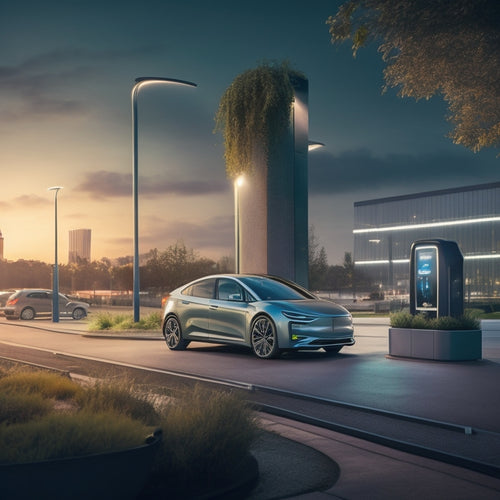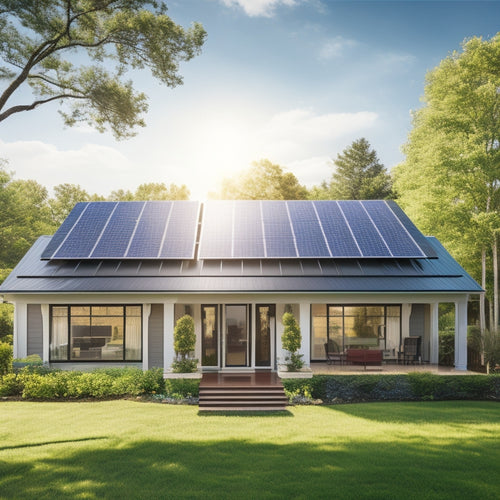
Transitioning to Solar Energy for Business
Share
Shifting to solar energy can save your business over 20% on energy bills in just a few years. With financial incentives like the Solar Investment Tax Credit, your initial investment becomes more manageable. You'll lock in predictable energy costs, reducing the risk of market volatility. Plus, adopting solar reduces your carbon footprint, enhancing your brand's reputation among environmentally conscious consumers. Understanding the best inverter technology and analyzing your energy needs will maximize efficiency and performance. If you're curious about the specific steps to take and further benefits, there's more to uncover on this expedition to renewable energy.
At a Glance
- Transitioning to solar energy can lead to over 20% savings on energy bills within a few years through reduced operational costs.
- Financial incentives like tax credits and PPAs minimize upfront costs, ensuring a quicker payback period for solar investments.
- Utilizing solar energy enhances brand reputation and attracts environmentally conscious consumers, promoting a positive sustainability image.
- Properly selecting high-efficiency solar panels and monitoring system performance maximizes energy output and investment reliability.
- Implementing solar energy provides predictable costs, helping businesses effectively budget and avoid fluctuations in utility expenses.
Cost Savings Over Time
When you consider shifting to solar energy, it's essential to analyze the initial investment versus the long-term savings potential.
While the upfront costs might seem intimidating, the decreasing energy bills and available tax incentives can greatly offset that investment over time.
By leveraging the Solar Investment Tax Credit (ITC), businesses can reduce their initial installation costs, further enhancing the financial feasibility of solar energy.
Initial Investment Analysis
A well-planned shift to solar energy can lead to significant cost savings over time, often exceeding 20% on energy bills within the first few years. This change requires an initial investment, but it's essential to see this as a strategic move toward financial freedom rather than a mere expense.
When you consider financing options, various plans can help you minimize upfront costs. Many businesses opt for power purchase agreements (PPAs) or solar leases, allowing you to pay little to nothing upfront while still reaping the benefits of solar energy.
Additionally, tax incentives play an important role in reducing your overall investment. Federal and state tax credits can cover a substantial portion of installation costs, making solar solutions even more appealing.
These incentives can drastically reduce your payback period, often allowing you to recover your investment within a few years.
Long-Term Savings Potential
By embracing solar energy, businesses can access substantial long-term savings that greatly impact their bottom line. The initial investment in solar technology may seem intimidating, but with various financing options and government incentives available, your ROI calculation can show promising results.
Consider the table below that outlines potential long-term savings:
| Savings Category | Estimated Savings Over 25 Years |
|---|---|
| Energy Costs | $150,000 |
| Maintenance Costs | $10,000 |
| Tax Benefits | $25,000 |
These savings stem from reduced energy costs, lower maintenance expenses, and available tax benefits. Investing in energy storage and grid integration can also enhance energy independence, further decreasing reliance on fluctuating utility rates and nurturing utility partnerships.
While your upfront costs may include solar panel installation, these expenditures are often offset by the long-term financial benefits. By evaluating your options and understanding the potential savings, you can make an informed decision that supports sustainable growth. Ultimately, moving to solar energy isn't just an eco-friendly choice; it's a strategic move towards significant financial freedom for your business.
Environmental Impact Reduction
Shifting to solar energy considerably lowers your business's carbon footprint, positioning you as a leader in sustainable practices.
By implementing energy conservation strategies, you not only contribute to environmental preservation but also enhance your brand's reputation.
Embracing solar technology is a proactive step towards a greener future that benefits both your bottom line and the planet.
Lower Carbon Footprint
Implementing solar energy solutions can greatly lower your business's carbon footprint, contributing to a healthier planet. By utilizing the sun's power, you reduce reliance on fossil fuels, which are major contributors to greenhouse gas emissions. This change not only enhances your environmental responsibility but also positions your company as a leader in sustainability.
Adopting solar energy enables you to adopt effective carbon offset strategies, where the decrease in carbon emissions compensates for any residual emissions your business may produce. This proactive approach not only strengthens your brand image but also connects with environmentally conscious consumers who value sustainability in their purchasing decisions.
Furthermore, achieving renewable energy certifications showcases your commitment to reducing environmental impact. These certifications can enhance your credibility, making your business more attractive to partners and customers alike while potentially revealing financial incentives.
In today's market, where freedom and responsibility go hand in hand, shifting to solar energy is more than just an ethical choice. It's a strategic decision that equips your business to thrive in a competitive environment while making a positive difference for the planet.
Adopt solar energy, and watch your carbon footprint shrink.
Sustainable Energy Practices
Adopting sustainable energy practices can greatly reduce your business's environmental impact while also enhancing operational efficiency. By integrating renewable energy sources, like solar power, you not only contribute to a cleaner planet but also position your business as a leader in environmental responsibility.
Utilizing green technology and implementing energy conservation strategies can lead to significant cost savings and improved energy efficiency.
Consider taking advantage of solar incentives that make shifting to clean power more affordable. These incentives can subsidize your initial investment, clearing the path toward energy independence.
By committing to sustainable practices, you're not just reducing your carbon footprint; you're also optimizing resource management, ensuring that your operations are both efficient and effective.
As you accept these changes, you enable your business to thrive in a market that increasingly values environmentally conscious choices. The move to sustainable energy isn't just about compliance; it's about seizing the opportunity for growth while making a positive impact.
Inverter Efficiency and Performance
When shifting to solar energy, understanding inverter efficiency is essential for maximizing your system's performance.
You'll encounter various types of inverters, each with distinct performance metrics that affect energy output and overall cost-effectiveness.
Types of Inverters
As businesses investigate solar energy options, understanding the different types of inverters is vital for maximizing efficiency and overall performance. You'll encounter several inverter types, each customized to specific needs and configurations.
Grid tied inverters are designed for systems connected to the utility grid, allowing you to sell excess energy back, while off grid inverters store energy for standalone systems.
If you're considering flexibility, microinverter technology offers distinct advantages, allowing each panel to operate independently, optimizing performance even in partial shading.
String inverters, often favored for their simplicity, provide cost-effective solutions but can lose efficiency if one panel underperforms. On the other hand, hybrid inverter systems combine the benefits of grid-connected and off-grid inverters, granting you more energy freedom.
Don't overlook important aspects like inverter warranties, which protect your investment, and regular inverter maintenance to guarantee long-term functionality.
Compatibility with your existing system is essential, as is proper inverter installation and monitoring to maximize performance.
Performance Metrics Explained
Understanding performance metrics is fundamental for evaluating inverter efficiency and performance. When you're shifting to solar energy for your business, it's essential to focus on performance benchmarks that gauge how well your inverter converts solar energy into usable power. High inverter efficiency means more energy produced, which directly impacts your bottom line.
By implementing strong system monitoring, you can track key performance indicators like efficiency rates and energy output. This data allows you to identify any inefficiencies and optimize your solar system's performance. For example, if your inverter consistently falls below the expected benchmarks, you can investigate potential issues such as shading, equipment malfunctions, or improper installation.
Regular assessment of these metrics not only guarantees the reliability of your solar investment but also equips you with the knowledge to make informed decisions. You deserve the freedom to capture the full potential of solar energy, and understanding how to measure inverter performance is an essential step in that process.
Adopt these perspectives, and you'll be well on your way to maximizing your energy independence while minimizing costs.
Selecting Based on Energy Output
When selecting solar solutions for your business, it's essential to first assess your energy needs to guarantee the system you choose can meet them.
Understanding the key components of a solar power system, such as the solar panel array and inverter, will also help in making an informed decision.
Next, evaluating solar panel efficiency will help you maximize energy output and reduce costs.
Assessing Energy Needs
Evaluating your energy needs is essential for a successful shift to solar energy. To make an informed decision, you should start with a thorough load analysis. This process involves appraising your energy consumption patterns, identifying peak usage times, and understanding the total energy demand of your business.
By gaining perspectives into your specific energy requirements, you can effectively size your solar system to match them.
Remember, it's not just about the number of panels; it's about guaranteeing they generate enough energy to cover your operational needs. If you underestimate your energy consumption, you might end up with insufficient power, leading to increased reliance on conventional sources.
On the flip side, overestimating can mean wasted investment in unnecessary capacity.
As you steer through this change, consider how much freedom you desire from fluctuating energy costs and grid dependence. A well-planned solar investment can free you from these pressures.
Conducting a detailed load analysis guarantees your solar setup aligns with your business objectives, allowing you to utilize the power of the sun efficiently and sustainably.
Evaluating Solar Efficiency
As you investigate solar energy options, determining the efficiency of your solar panels is vital for maximizing energy output. Different solar panel types, such as monocrystalline, polycrystalline, and thin-film, have varying efficiency levels.
Monocrystalline panels generally boast the highest efficiency, often exceeding 20%, making them ideal for limited space. However, they tend to come at a higher cost.
Polycrystalline panels, while slightly less efficient, offer a more budget-friendly option without sacrificing too much in performance.
Thin-film panels are the least efficient but can be advantageous in specific applications where flexibility and weight are key considerations.
It's important to match your solar panel choice with your energy storage solutions. High-efficiency panels paired with a strong energy storage system can help you utilize and store excess energy for use during peak times or cloudy days.
This combination not only enhances your energy independence but also reduces reliance on traditional energy sources.
Ultimately, evaluating the efficiency of solar panels allows you to make informed decisions that align with your business's energy needs and freedom aspirations.
Prioritize efficiency to guarantee you're maximizing your investment in solar energy.
Long-Term Energy Price Stability
When you shift to solar energy, you gain a significant advantage: predictable energy costs.
Unlike traditional energy sources, which can fluctuate wildly due to market conditions, solar power allows you to forecast your expenses with confidence.
This stability not only helps in budgeting but also protects your business from unexpected price hikes in the future.
Predictable Energy Costs
Investing in solar energy offers businesses a unique advantage: predictable energy costs. Unlike traditional energy sources, which are often subject to volatile market fluctuations, solar power enables you to lock in your energy expenses. This energy predictability is essential for effective cost management, allowing you to budget with confidence and allocate resources more efficiently.
When you shift to solar, you're not just investing in technology; you're securing a stable financial future. With fixed energy costs over the lifespan of your solar system, you can sidestep the unpredictable spikes in utility bills that can derail your financial plans. This stability enables you to focus on growth and innovation rather than worrying about rising energy prices.
Moreover, solar energy systems often come with tax incentives and rebates that can further enhance your cost savings. By reducing your dependence on fossil fuels, you're not only safeguarding your bottom line but also contributing to a more sustainable future.
Adopt solar energy to gain control over your energy expenses and enjoy the freedom that comes with predictable costs—because your business deserves stability in a rapidly changing world.
Frequently Asked Questions
What Initial Investments Are Required for Solar Energy Systems?
When considering solar energy systems, you'll face installation costs and must investigate various financing options. Evaluating these aspects carefully can lead to significant savings and a sustainable energy future, enabling you to gain financial independence.
How Long Does the Installation Process Typically Take?
The installation timeline usually spans several weeks, depending on project phases. You'll experience site assessment, permitting, and installation, each critical for ensuring efficiency. Understanding this process helps you prepare and accept the freedom solar energy offers.
Are There Tax Incentives for Businesses Switching to Solar?
When it comes to tax incentives, you've got a golden opportunity. Federal credits, state rebates, financing options, and solar leasing can enhance your energy savings and return on investment, making the switch worthwhile for your business.
How Do Solar Panels Perform in Cloudy Weather?
Solar panels still generate energy in cloudy conditions, though their efficiency drops compared to sunny days. By understanding this, you can appreciate how reliable solar energy can be, even when the sun isn't shining brightly.
What Maintenance Is Needed for Solar Energy Systems?
To maintain system efficiency, you should perform routine inspections on your solar energy system. Regular checks guarantee ideal performance, preventing potential issues and maximizing your energy independence. Stay proactive to enjoy the freedom solar power offers.
Explore More
Shifting to solar energy isn't just a smart financial move; it's your chance to join the ranks of innovators shaping a sustainable future. By embracing solar power, you're not only cutting costs and stabilizing energy prices but also reducing your environmental footprint. Think of it as planting a seed for a greener tomorrow—one that could yield significant returns. So, why not take the leap? The sun's shining, and your business could be reaping the benefits in no time.
Related Posts
-

Solid State Batteries in Electric Vehicles
Solid-state batteries revolutionize electric vehicles by offering a longer lifespan and higher energy density than tr...
-

Smart Home Thermostats to Revolutionize Your Space
Smart home thermostats revolutionize your space by providing precise temperature control and optimizing energy saving...
-

Home Solar Installation Cost
You're considering installing solar panels on your home, and the upfront cost is likely the biggest hurdle standing i...


